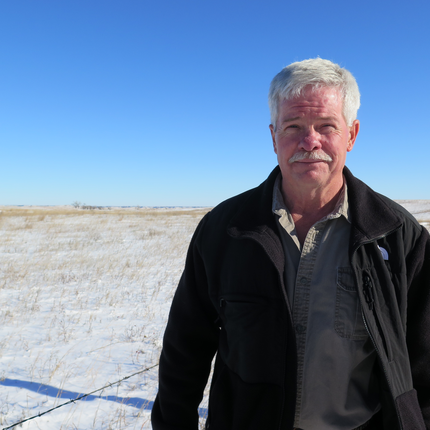The Sandhill & Sun Ranch is located on just over 2600 acres in northwestern Brown County, Nebraska. Al and Lois Steuter, along with their four kids, developed a family cattle business where simplicity is a defining characteristic and where land management is an investment in the future, informed by the past.
“I like to think of my management of native Sandhills prairie as being similar to managing an endowment. It has the perfect investment horizon – forever. You’re bound to do okay with an adaptive and diverse portfolio. It’s the mix of hundreds of native species that make it work.”
Al’s conservation portfolio is focused on maintaining species diversity through year-round grazing with prescribed fire to control cedars. He manages for native species by paying close attention to the stocking rate of the cattle managed within seasonally deferred grazing rotations in 16 pastures ranging in size from 20 to 560 acres. Cattle are managed in three herds, older cows, younger cows and weaned calves/yearlings because of their differing nutritional needs.
Just like any permanent endowment, you use a portion of the annual surplus – about half of the annual above-ground production,” said Al, who describes his management style as “minimalist” and “conservative.”
When Al and Lois started Sandhill and Sun in 1990, they did so with full-time jobs and four kids. They focus on easy-keeping red angus cows they keep on grass year-round and supplement with protein/energy cubes in the winter and with hay only when severe blizzards make that necessary.
Al’s professional and academic background in grazing and fire ecology have translated into conservation practices that emphasize the natural ecosystem and are informed by historic interactions between bison and fire.
“Bison are year-round grazers and I wanted to mimic that as much as I could with cattle,” said Al, who developed Sandhill & Sun Ranch in tandem with a full-time job managing the Nature Conservancy’s Niobrara Valley Preserve. Adjacent to the Steuter’s ranch, the Preserve is one of the Conservancy’s largest preserves in the U.S. and a national model for grassland management using bison, cattle and fire.
Bison and fire were an integral part of the Great Plains prairie ecosystem before settlement: the bison freely roaming a large part of the country, grazing in such a way that maintains plant diversity and the balance between grasses and forbs. Prairie wildfires set by lightning or Native Americans were equally important in this natural system, stimulating new plant growth, creating lush, diverse and healthy grasslands.
“Out here in the Sandhills, fire is primarily for woody plant control,” said Al. Land managers use controlled fire, known as prescribed burning, as a conservation tool mainly to control the spread of eastern red cedar trees. Al has overseen more than 200 prescribed burns – totaling more than 50,000 acres – on his ranch, on other private rangeland, and on grassland preserves across the country.
Some burning at Sandhill and Sun is done with a conservation program called the Natural Legacy Project, implemented by Nebraska Game and Parks. The project’s mission is to conserve Nebraska’s flora, fauna, and natural habitats through the proactive, voluntary conservation actions of partners, communities, and individual landowners. The program is part of a national effort to address the needs of declining wildlife populations, including 700 at-risk species identified in Nebraska.
In the Biologically Unique Landscape of the Middle Niobrara – a priority landscape defined by Game and Parks – conservation strategies include: planned grazing strategies on private lands, efforts to control invasive species, increasing tree thinning and the use of prescribed fire, and the implementation of conservation easements. The Natural Legacy Project offers support to ranchers to implement these practices for specific at-risk terrestrial and aquatic communities, plants and animals.
“I’m an ecologist by nature. I think I was born that way,” said Al. “I like having some of the natural world left, and I am especially passionate about maintaining our remaining grasslands for their economic and ecological value to our country.” Al has worked nationally and internationally as a consultant on private grasslands and preserves. In the big picture, he sees the loss of native grasslands – the ongoing transition to farmland and other land uses – as the biggest conservation challenge.
The Steuters work to counteract the trend on their own land by actively working to maintain healthy populations of native plant and animal species. Mule deer, sharp-tailed grouse, pronghorn antelope, badger and prairie dogs are common sights at Sandhill and Sun. A whole host of prairie birds, insects, and small mammals interact with grazing animals just as they have for thousands of years.
“Grasslands have value that will pay off. You can manage them well and have a good living,” said Al. “You don’t have to change them to something else. I think we’ve proved that.”
Feature image: Al Steuter is a passionate advocate for grasslands conservation. Photo above, land managers in the Sandhills use prescribed burning as an effective conservation tool to control invasive eastern red cedar trees. Photos by Kat Shiffler






